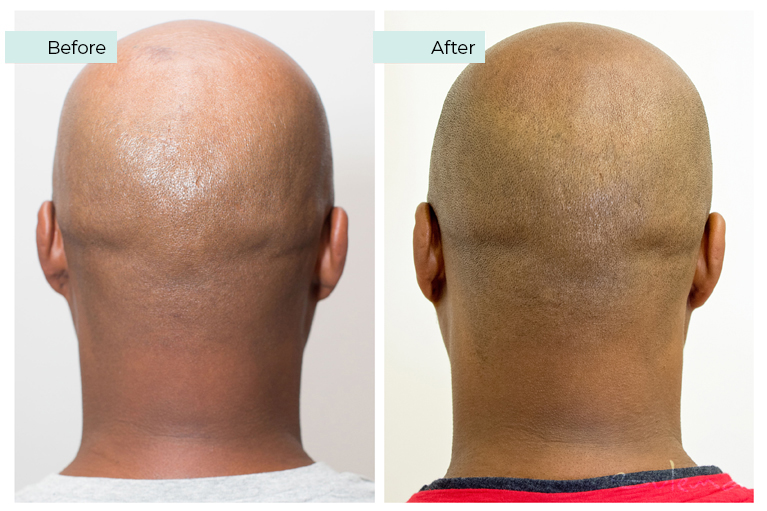Without a doubt, scalp micropigmentation is the fastest growing solution for male hair loss in recent history.
It is non-invasive, has universal appeal and is permanent, but only if you want it to be. Furthermore, it remains the only permanent hair loss fix to offer instantaneous, guaranteed results.
Tiny micro-dots are placed into the scalp to create the illusion of a hair follicle.

SGURU- Scalp micropigmentation is the process of replicating the appearance of shaven hair, by introducing thousands of tiny pigment deposits into the epidermis of the scalp. When placed by a skilled technician, the recipient appears as if they have a full head of hair, shaved to a very short length.
* The world’s fastest growing solution for hair loss, scalp pigmentation has exploded in popularity.
More men than ever before, and an increasing number of women, are choosing scalp pigmentation in favor of traditional remedies such as hair transplant surgery, concealers, hair systems and drug-based solutions.
What is the treatment process?
A relatively simple treatment to undertake, the scalp micropigmentation method consists of depositing small ‘dots’ of pigment into the dermal layer of the skin, with the use of a fine needle. Combined with thousands of other ‘dots’, an illusion of a full head of shaved hair is created.
The client usually requires 2-3 sessions, each lasting approximately 2-3 hours, but time does vary depending on individual requirements. The process is repeated until both the technician and client are satisfied that the semblance of hair cannot be distinguished from the surrounding real hair.
Common applications
Scalp micropigmentation can be applied to much wider range of hair loss variations than hair transplant surgery; from general balding to hairline recession, to burn or surgery related hair loss, and of course alopecia (most commonly alopecia areata). It can be also utilised to conceal hair transplant scars or blemishes as a result of trauma to the head. The method can even be adapted to blend noticeable birthmarks into the scalp.
Does the treatment hurt?
Most people experience a mild amount of discomfort during the early stages of the session, though this tends to become more tolerable as the session progresses. Some areas of the scalp have a denser collection of nerve endings than others, particularly at the sides of the head, and can often be the most challenging to deal with, but many choose to focus on the benefits and the final of the treatment to help contain the sensation.
What is the recovery period?
Once the pigments are deposited, the skin needs to heal. A recovery period of one week should be allowed, so that the micro-wounds created during the procedure may dry up and close while the pigments get assimilated into the dermal layer.
The treatment process must likewise follow a fairly strict procedure that allows the patient’s scalp to heal between treatment sessions. The industry standard timescales are as follows:
- Day 1 – first session
- Day 8 (or later) – second session
- Day 15 (or later) – third session
Basically leave a minimum of one week between each session, however there are a couple of considerations.
First, it is feasible to leave just 5 days between each session for clients who have an issue with time, for example when they’re traveling from far away for their procedure. Second, it is common to leave several weeks between the second and third sessions, to allow time for the pigments to fully settle and to establish whether or not a third session is actually needed.
Are there any common side effects?
Micropigmentation in general has very limited side effects and does not tend to cause adverse reactions. This is because the technique addresses the visual symptom, (the hair loss itself) rather than the underlying cause. This makes a full medical diagnosis less important. Whilst the side effects are limited, the advice of a technician prior to starting treatment is still necessary.
How much does scalp micropigmentation cost?
Treatments vary from clinic to clinic, and also depend heavily on the clients requirements. For comprehensive guidelines see our scalp micropigmentation cost calculator.
Experience is key
A successful scalp procedure relies on an accurate appearance of hair follicles. Pigments that do not blend well with surrounding natural hair follicles, for example deposits that are larger or darker, can cause the treatment to look unnatural and lead to its detection by others. The assistance of an experienced technician regarding the style and specifics of the treatment will ensure that the client leaves the clinic with natural looking ‘hair’ each and every time.
This best results can only be achieved by an experienced technician who has received adequate training, and worked with enough clients to hone their skills. In addition to this, the right inks, needles and equipment specifically made for scalp micropigmentation should be used to ensure consistency and lasting results. The technician should also be well reviewed by past clients.
How long does the illusion last?
Everyone wants to know how long their treatment will last. The nature of the process means that it will fade slowly over a period of time. Whilst the pigments will probably remain visible for 20 years or more, regular top-ups are needed to keep your ‘hair’ looking its best. Most clients find they need top-ups every 3-5 years.
For maximum longevity, it is important to keep the scalp in a good condition. Ensure that your head is cleansed and moisturized daily, take adequate precautions in the sun and avoid topical products that contain alcohol.
Despite this, I would have no problem telling my friends the truth if they ever questioned me about my SMP, no problem at all. Would I be so comfortable with that discussion if I’d had a hair transplant, was wearing a wig or had a head full of keratin fibres? No way! But somehow telling my friends about my scalp micropigmentation treatment is just fine with me.
Minor hairline restructures
If you’ve receded only slightly, you may not need a full head treatment. Be aware however that as many as 50% of men who believe they can get away with just a hairline restructure are actually wrong, and end up being quoted for a full head treatment. This is because the hair has usually thinned considerably by the time the frontal hairline starts to recede, so clients simply do not realize how much density they’ve already lost.
General hair loss
Most clients need a full head treatment, meaning the entire top of the head, and a blending area into the ‘horseshoe’ Most clients from a Norwood 3 onwards will require this, even if they have a substantial amount of natural hair remaining. This happens because your upper crown area of the head needs to have its “hair density” increased through the treatment so that the top looks perfect when comparing it with the sides and the back of your head.
Camouflaging scars from hair transplants
Tissue that appears when a scar gets in place on the scalp is a bit trickier to work with and usually requires more sessions. A common scenario is for the client to have a full head treatment as detailed above, with the addition of scar camouflage work. Whilst the rest of the treatment may be complete after 2-4 sessions, the scar may need an additional session or two to achieve the optimum level of camouflage.
Clients with alopecia
Alopecia is a highly variable condition and it’s quite difficult to provide a flat rate, given the fact that the requirements of one customer might be entirely different from the next. The strategy that the clinic adopts during the preliminary discussions will have a bearing on the total price. This happens because certain users who suffer from extended alopecia symptoms need to get their full head done, while minor symptoms can be covered with a partial treatment. Usually, clients with alopecia areata or alopecia totalis will require a full head treatment, including the entire side profile areas and down to the nape of the neck. For clients with alopecia totalis, density is created from scratch which of course takes longer to achieve.
Disguising alopecia is approached differently by SMP and tricopigmentation technicians. When applying permanent SMP, most technicians will recommend that your full head is treated to allow for changes in your symptoms, i.e if your bald patches move, change shape or size. However, tricopigmentation technicians commonly treat the existing patches and a small surrounding area. This is because tricopigmentation is temporary, therefore a long term contingency plan in case your symptoms change is not required.
Please ensure you deal with a clinic that has specific experience in camouflaging alopecia, as this is a highly specialised area and should not be attempted by a rookie.
Maintenance costs
Fading will inevitably occur. Clients will have to visit their clinic once every 3-5 years. Tricopigmentation clients require top-ups every 12-18 months.
You might also want to change your style and both options allow you to do this, although tricopigmentation does offer more flexibility in this area. Some clinics charge an hourly rate for services such as these, whilst others will offer a fixed quotation.
Have hair transplants?
Compliment a hair transplant by filling in with micro dots and make it look like you have more hair.
Are you bald?
You can now appear to have a SHAVED HEAD LOOK. No more shiny bald head. Hello sexy.


